Experimental Investigation on the Machinability Improvement in Magnetic-Field-Assisted Turning of Single-Crystal Copper
Abstract
1. Introduction
2. Experimental Procedure
3. Results and Discussions
3.1. Magnetic-Field-Distribution Analysis
3.2. Cutting Force and Friction Coefficient
3.3. Chip Morphology
3.4. Surface Quality
4. Conclusions
- Magnetic-field action with magnetic-flux density of 0.38 T is introduced into a single-point diamond-turning system by neodymium iron magnets, to carry out magnetic-field-assisted turning. The cutting force in the magnetic-field-assisted turning increases up to 1.6 times more than the conventional turning because of the additional Lorentz force, which is induced by the equivalent conductor which cuts the magnetic-induction line during the metal-cutting process. Compared with conventional turning, magnetic-field-assisted turning can decrease the cutting-force ratio and friction coefficient on the rake face by approximately 16%, because of the modified tribological property on the tool/chip contact.
- The chip-compression ratio in magnetic-field-assisted turning is smaller than the conventional turning. Magnetic-field-assisted turning tends to obtain continuous-chip-side morphology with a lower level of chip deformation, due to the magnetoplasticity mechanism. Magnetic-field-assisted turning is helpful for improving metal machinability with friction reduction and the magnetoplasticity effect, the average surface-roughness reduces, from 16.2 nm to 15 nm.
Author Contributions
Funding
Data Availability Statement
Acknowledgments
Conflicts of Interest
References
- Zhang, S.J.; To, S.; Wang, S.J.; Zhu, Z.W. A review of surface roughness generation in ultra-precision machining. Int. J. Mach. Tools Manuf. 2015, 91, 76–95. [Google Scholar] [CrossRef]
- Shahrokh, H.; Khaled, A.E.H. Review of non-conventional technologies for assisting ultra-precision single-point diamond turning. Int. J. Adv. Manuf. Technol. 2020, 111, 2667–2685. [Google Scholar]
- Dai, Y.; Jiang, J.; Zhang, G.; Luo, T. Forced-based tool deviation induced form error identification in single-point diamond turning of optical spherical surfaces. Precis. Eng. 2021, 72, 83–94. [Google Scholar] [CrossRef]
- Zhang, Z.; Yan, J.; Kuriyagawa, T. Manufacturing technologies toward extreme precision. Int. J. Extreme Manuf. 2019, 1, 022001. [Google Scholar] [CrossRef]
- Liu, H.T.; Zhu, X.F.; Sun, Y.Z.; Xie, W.K. Evolution of stacking fault tetrahedral and work hardening effect in copper single crystals. Appl. Surf. Sci. 2017, 422, 413–419. [Google Scholar] [CrossRef]
- Lee, W.B.; To, S.; Cheung, C. Effect of crystallographic orientation in diamond turning of copper single crystals. Scr. Mater. 2000, 42, 937–945. [Google Scholar] [CrossRef]
- Zhang, P.; Cao, X.; Zhang, X.; Wang, Y. Effects of cutting parameters on the subsurface damage of single crystal copper during nanocutting process. Vacuum 2021, 187, 109420. [Google Scholar] [CrossRef]
- Yang, Z.; Zhu, L.; Zhang, G.; Ni, C.; Lin, B. Review of ultrasonic vibration-assisted machining in advanced materials. Int. J. Mach. Tools Manuf. 2020, 156, 103594. [Google Scholar] [CrossRef]
- You, K.; Yan, G.; Luo, X.; Gilchrist, M.D.; Fang, F. Advances in laser assisted machining of hard and brittle materials. J. Manuf. Process. 2020, 58, 677–692. [Google Scholar] [CrossRef]
- Sachin, R.P.; Phaneendra, K.C. A review of magnetic-assisted machining processes. J. Braz. Soc. Mech. Sci. Eng. 2019, 41, 450. [Google Scholar]
- Muju, M.K.; Ghosh, A. A model of adhesive wear in the presence of a magnetic field. Wear 1977, 41, 103–116. [Google Scholar] [CrossRef]
- Muju, M.K.; Ghosh, A. Effect of a magnetic field on the diffusive wear of cutting tools. Wear 1980, 58, 137–145. [Google Scholar] [CrossRef]
- Kumagai, K.; Suzuki, K.; Kamiya, O. Study on reduction in wear due to magnetization. Wear 1993, 162, 196–201. [Google Scholar] [CrossRef]
- Fei, H.; Wu, H.; Yang, X.; Xiong, J.; Zhang, L.; Chen, Z.; Jiang, K.; Liu, J. Pulsed magnetic field treatment of cBN tools for improved cutting performances. J. Manuf. Process. 2021, 69, 21–32. [Google Scholar] [CrossRef]
- Zhang, L.; Guo, X.; Zhang, K.; Wu, Y.; Huang, Q. Enhancing cutting performance of uncoated cemented carbide tools by joint-use of magnetic nanofluids and micro-texture under magnetic field. J. Mater. Process. Technol. 2020, 284, 116764. [Google Scholar] [CrossRef]
- El Mansori, M.; Pierron, F.; Paulmier, D. Reduction of tool wear in metal cutting using external electromotive sources. Surf. Coatings Technol. 2003, 163–164, 472–477. [Google Scholar] [CrossRef]
- El Mansori, M.; Iordache, V.; Seitier, P.; Paulmier, D. Improving surface wearing of tools by magnetization when cutting dry. Surf. Coatings Technol. 2004, 188–189, 566–571. [Google Scholar] [CrossRef]
- Mkaddem, A.; Benabou, A.; El Mansori, M.; Clénet, S. Analytical modeling to predict the cutting behavior of ferromagnetic steels: A coupled magnetic–mechanical approach. Int. J. Solids Struct. 2013, 50, 2078–2086. [Google Scholar] [CrossRef][Green Version]
- Alireza, D.; Sasan, K.A.; Alireza, F.T.; Aminollah, M. Effects of magnetic assistance on improving tool wear resistance and cutting mechanisms during steel turning. Wear 2017, 384–385, 1–7. [Google Scholar]
- Yip, W.S.; To, S. Tool life enhancement in dry diamond turning of titanium alloys using an eddy current damping and a magnetic field for sustainable manufacturing. J. Clean. Prod. 2017, 168, 929–939. [Google Scholar] [CrossRef]
- Yip, W.; To, S. Reduction of material swelling and recovery of titanium alloys in diamond cutting by magnetic field assistance. J. Alloy. Compd. 2017, 722, 525–531. [Google Scholar] [CrossRef]
- Yip, W.S.; To, S. Reduction of tool tip vibration in single-point diamond turning using an eddy current damping effect. Int. J. Adv. Manuf. Technol. 2019, 103, 1799–1809. [Google Scholar] [CrossRef]
- Yip, W.S.; To, S. Control of the ductile and brittle behavior of titanium alloys in diamond cutting by applying a magnetic field. Sci. Rep. 2019, 9, 4056. [Google Scholar] [CrossRef] [PubMed]
- Shaw, M.C. Metal Cutting Principles; Oxford University Press: New York, NY, USA, 2005. [Google Scholar]
- Hatefi, S.; Abou-El-Hossein, K. Experimental investigation on the effects of magnetic field assistance on the quality of surface finish for sustainable manufacturing of ultra-precision single-point diamond turning of titanium alloys. Front. Mech. Eng. 2022, 8, 1037372. [Google Scholar] [CrossRef]
- Hatefi, S.; Abou-El-Hossein, K. Review of magnetic-assisted single-point diamond turning for ultra-high-precision optical component manufacturing. Int. J. Adv. Manuf. Technol. 2022, 120, 1591–1607. [Google Scholar] [CrossRef]
- Wu, X.; Du, M.; Shen, J.; Jiang, J.; Li, Y.; Liu, L. Experimental research on the top burr formation in micro milling. Int. J. Adv. Manuf. Technol. 2021, 117, 3477–3486. [Google Scholar] [CrossRef]
- Ji, P.Y.; Wang, J.A.; Ren, Z.M.; Wang, J.; Zhang, Y.F. Effect of crystal orientation on magneto-plasticity of mono-crystalline aluminium. Shang Hai Met. 2020, 42, 33–39. (In Chinese) [Google Scholar]
- Yip, W.S.; To, S. Reduction of Minimum Cutting Thickness of Titanium Alloys in Micro Cutting by a Magnetic Field Assistance. IEEE Access 2019, 7, 152034–152041. [Google Scholar] [CrossRef]
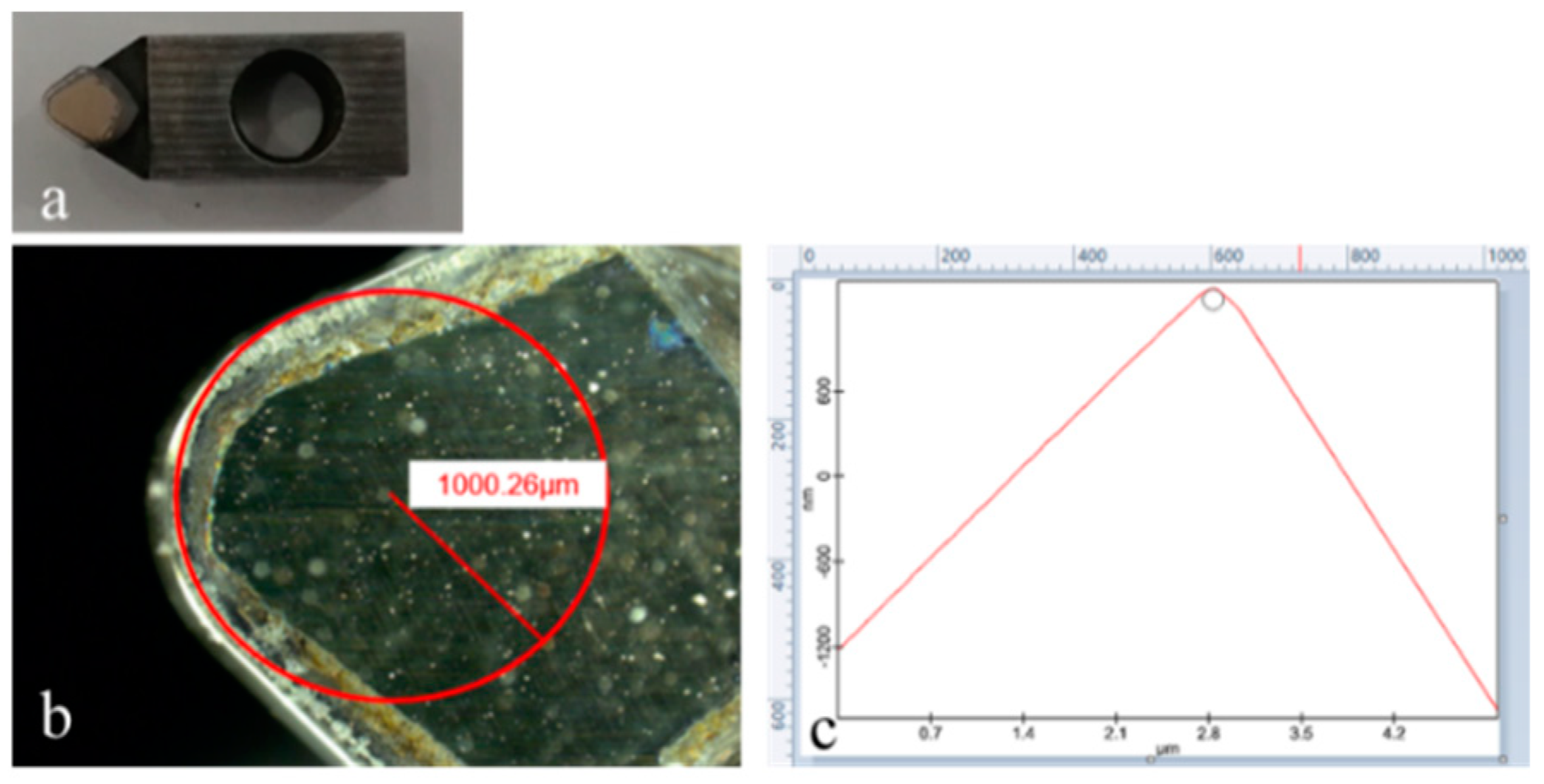
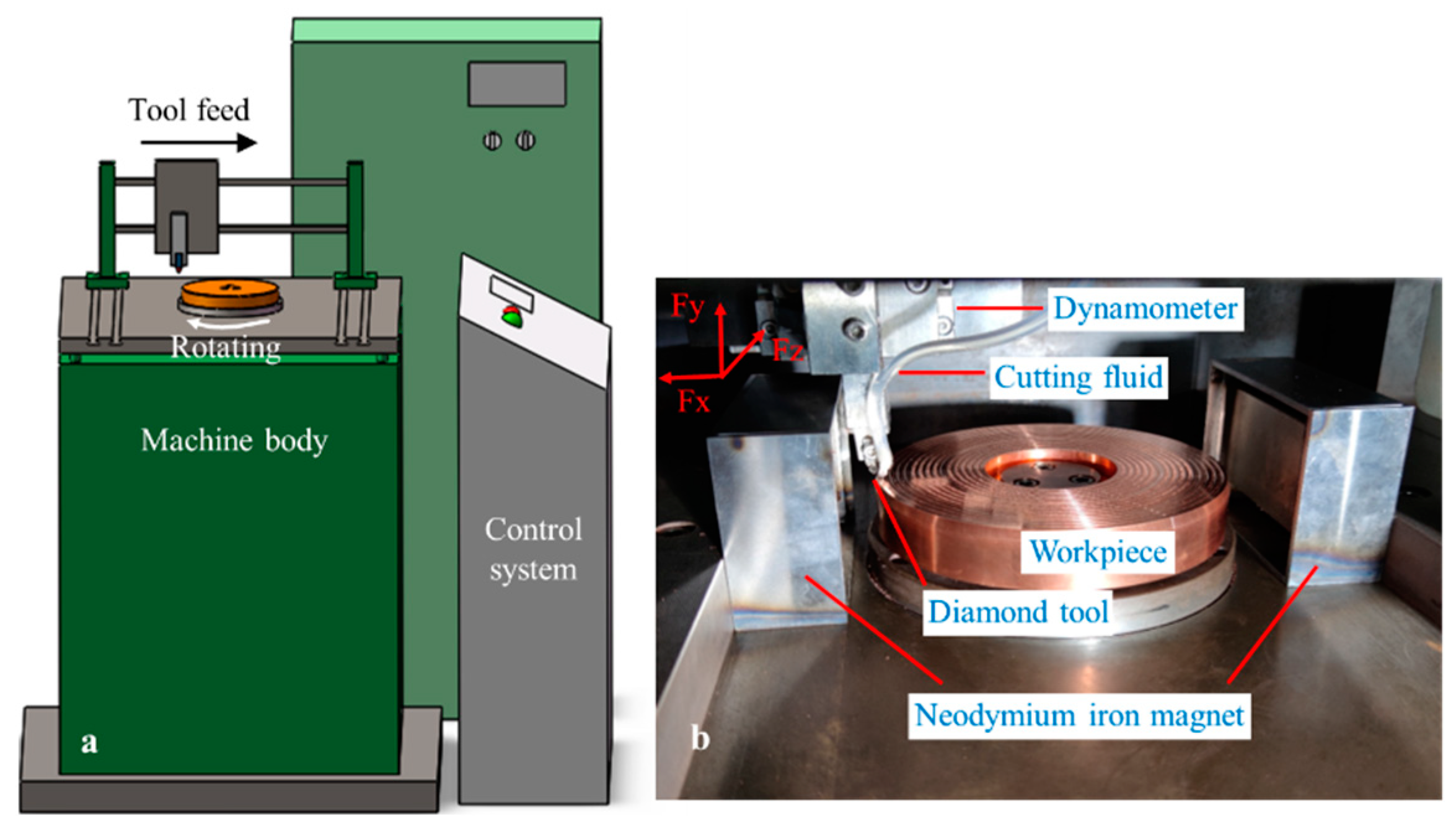

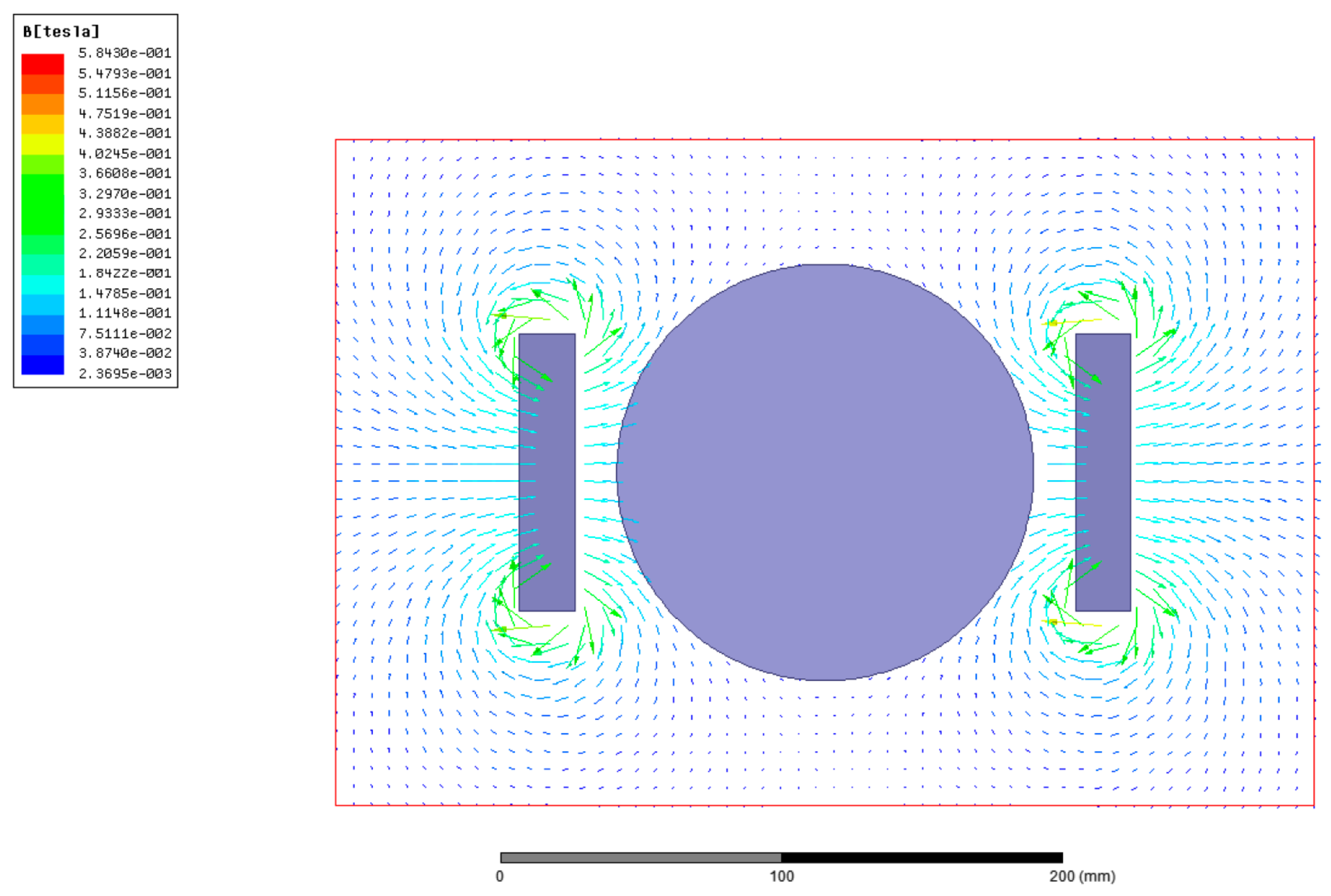


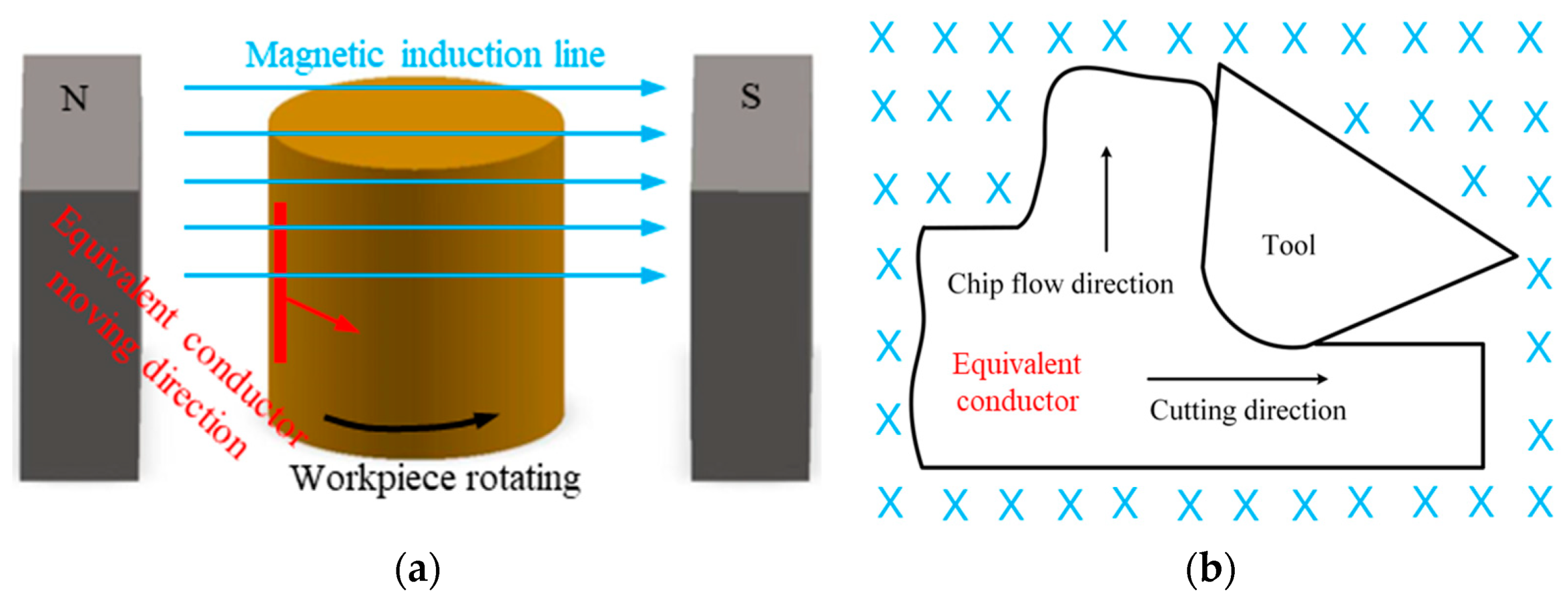
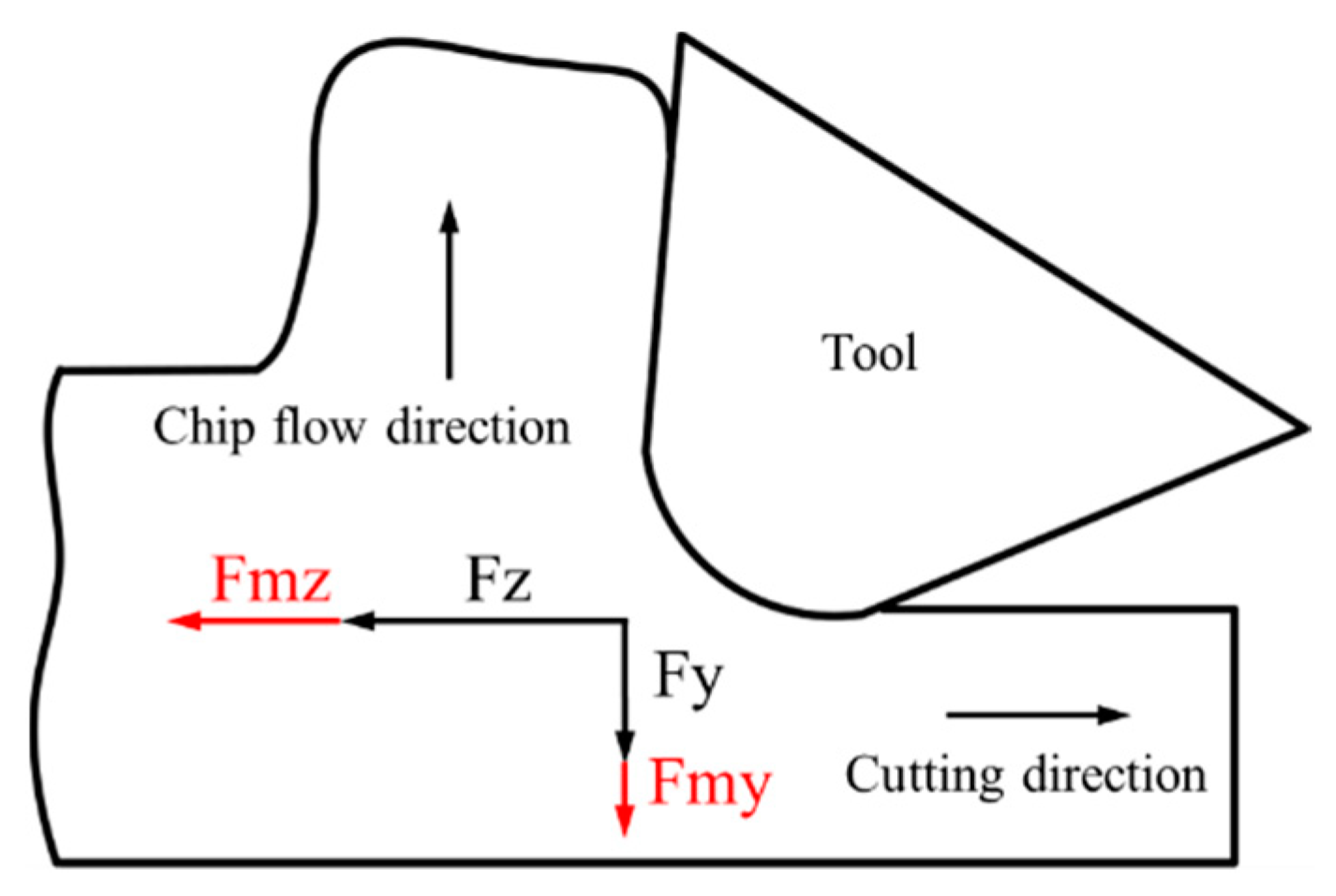
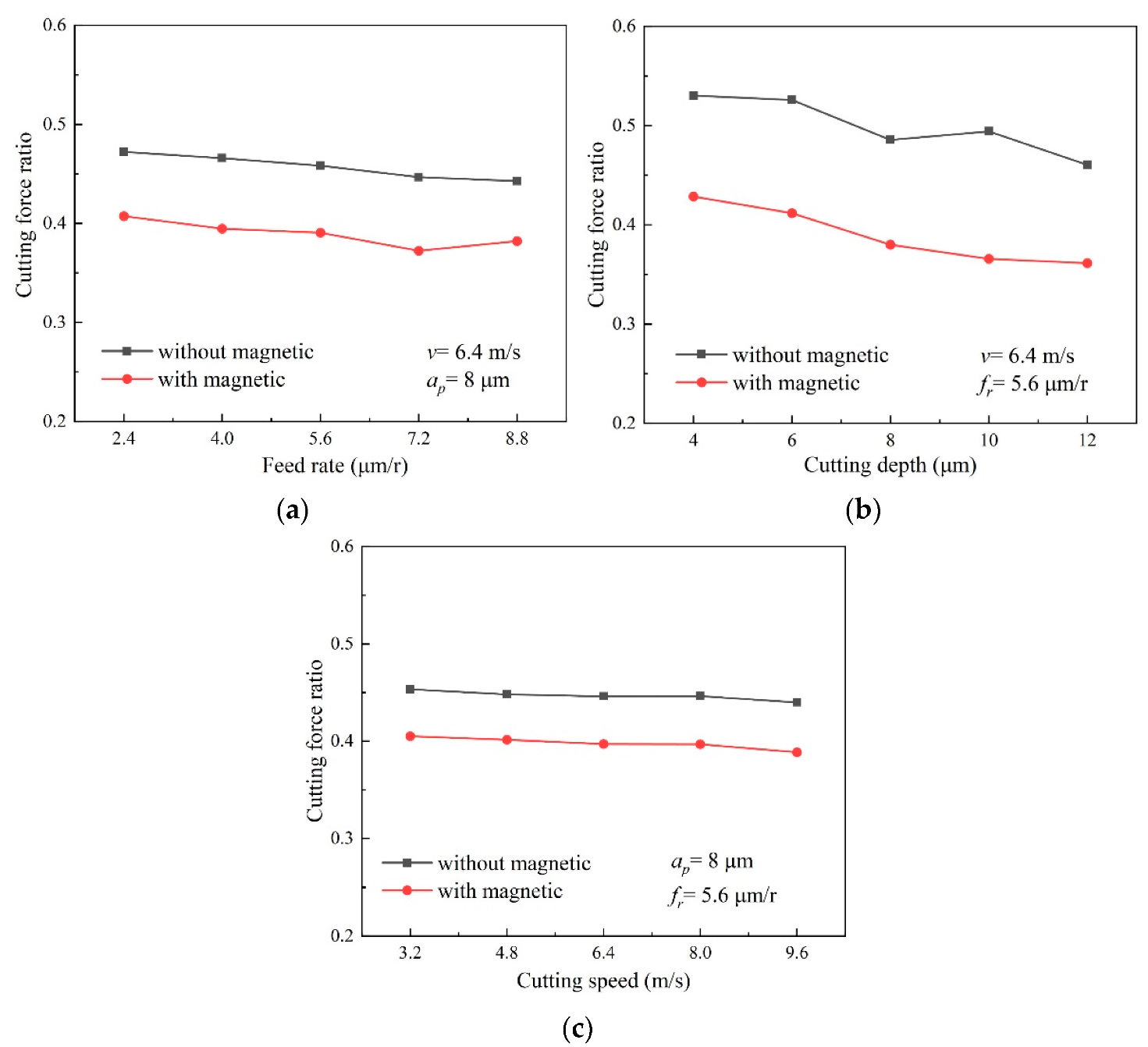
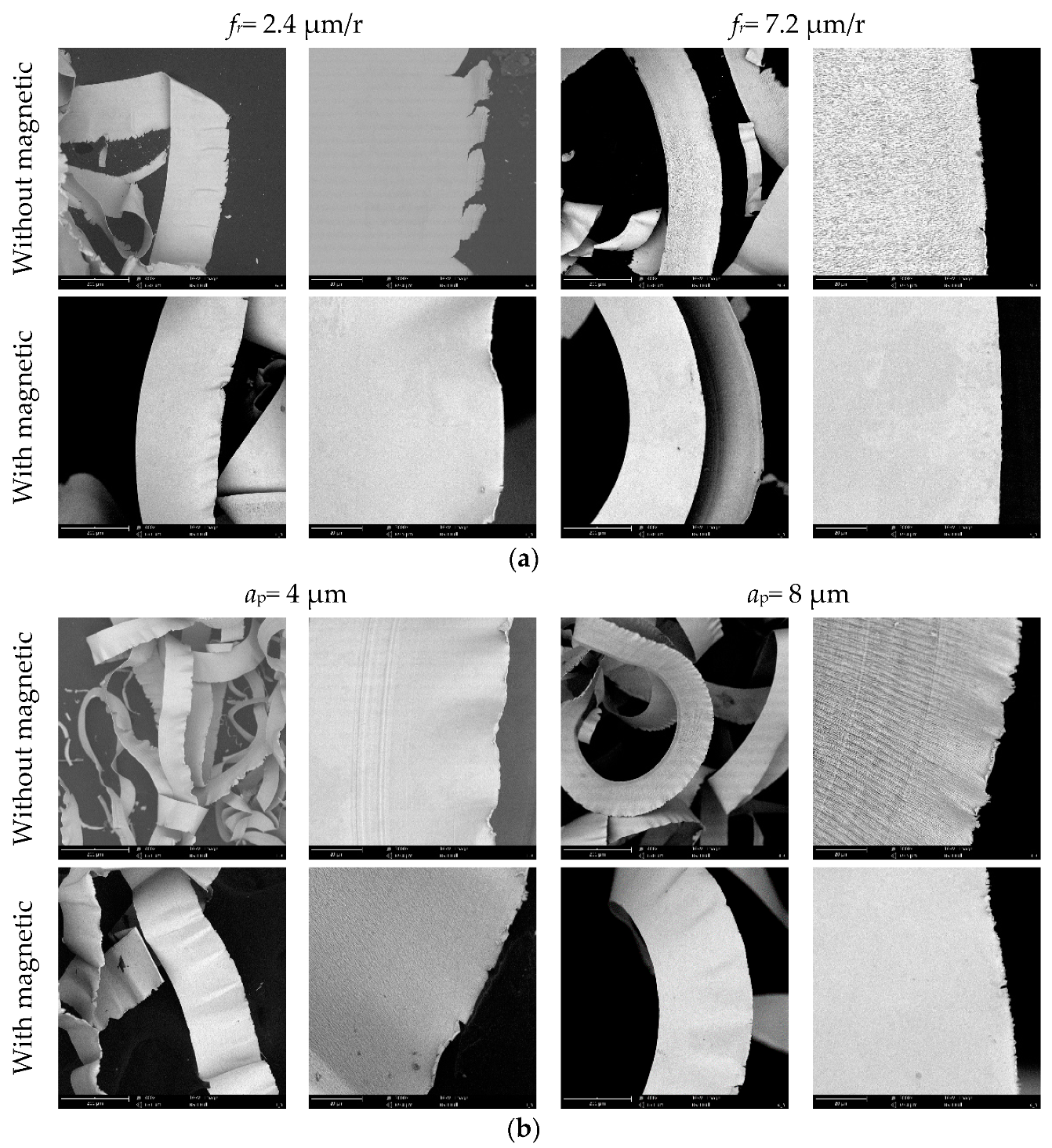
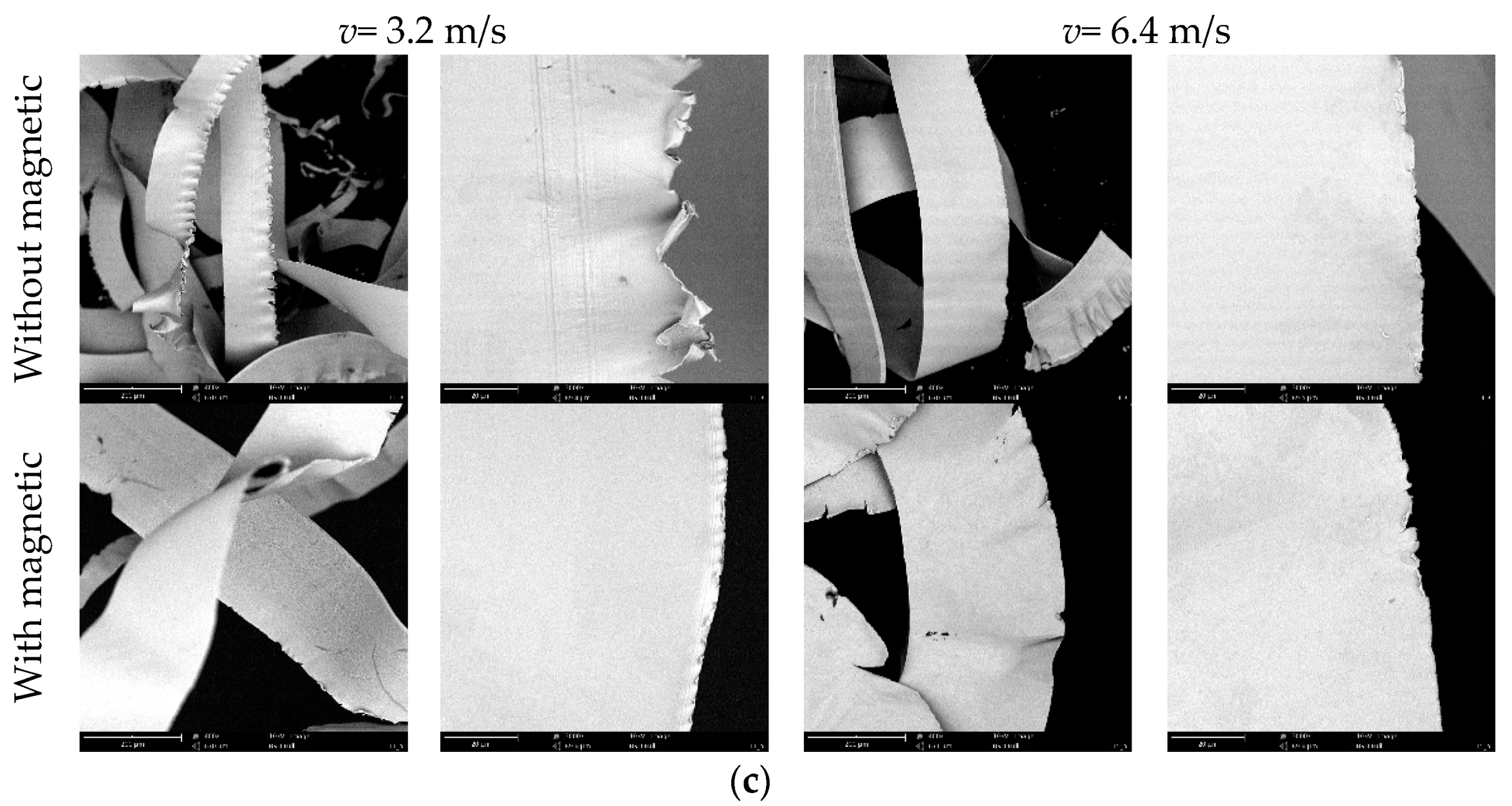
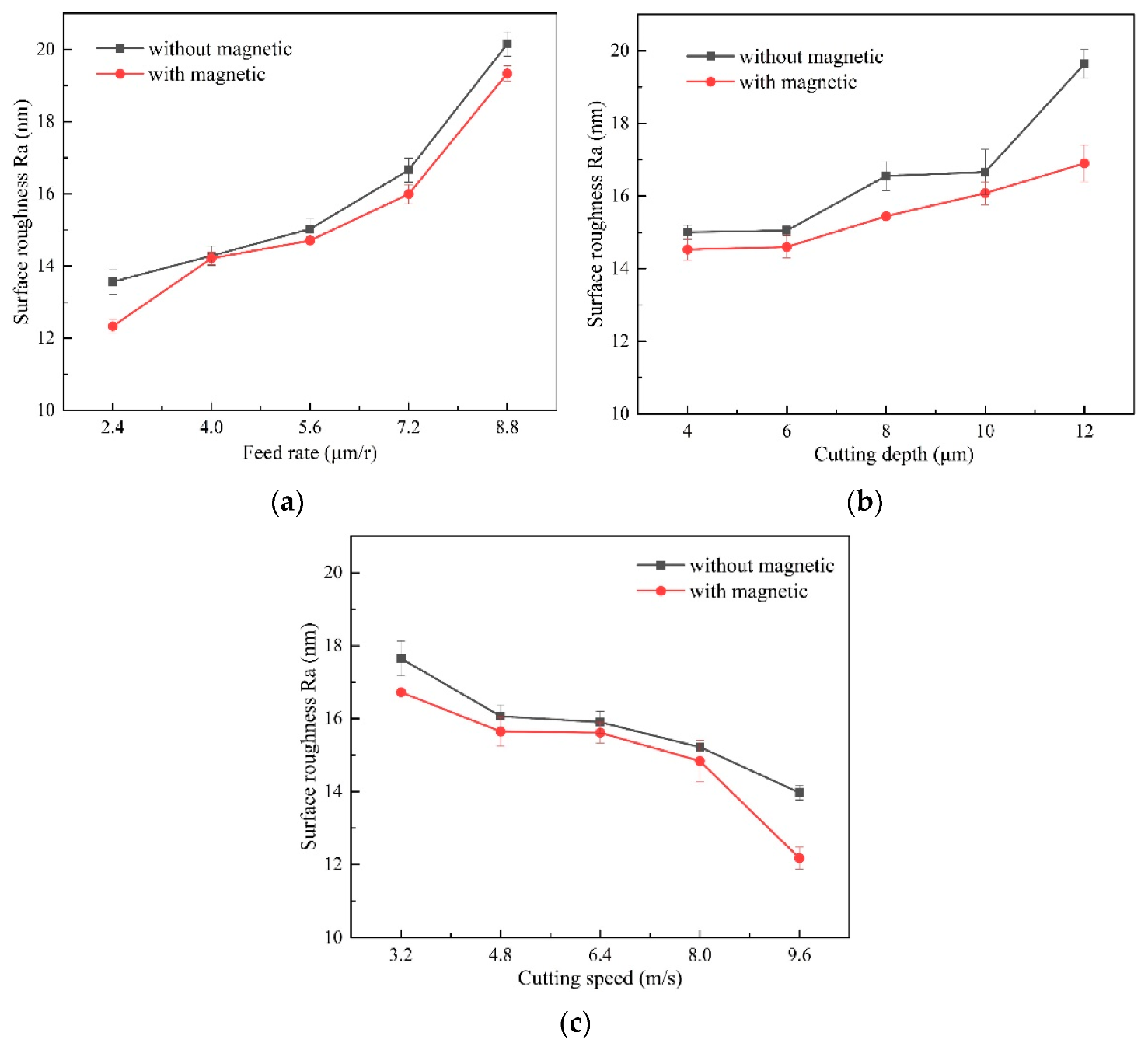
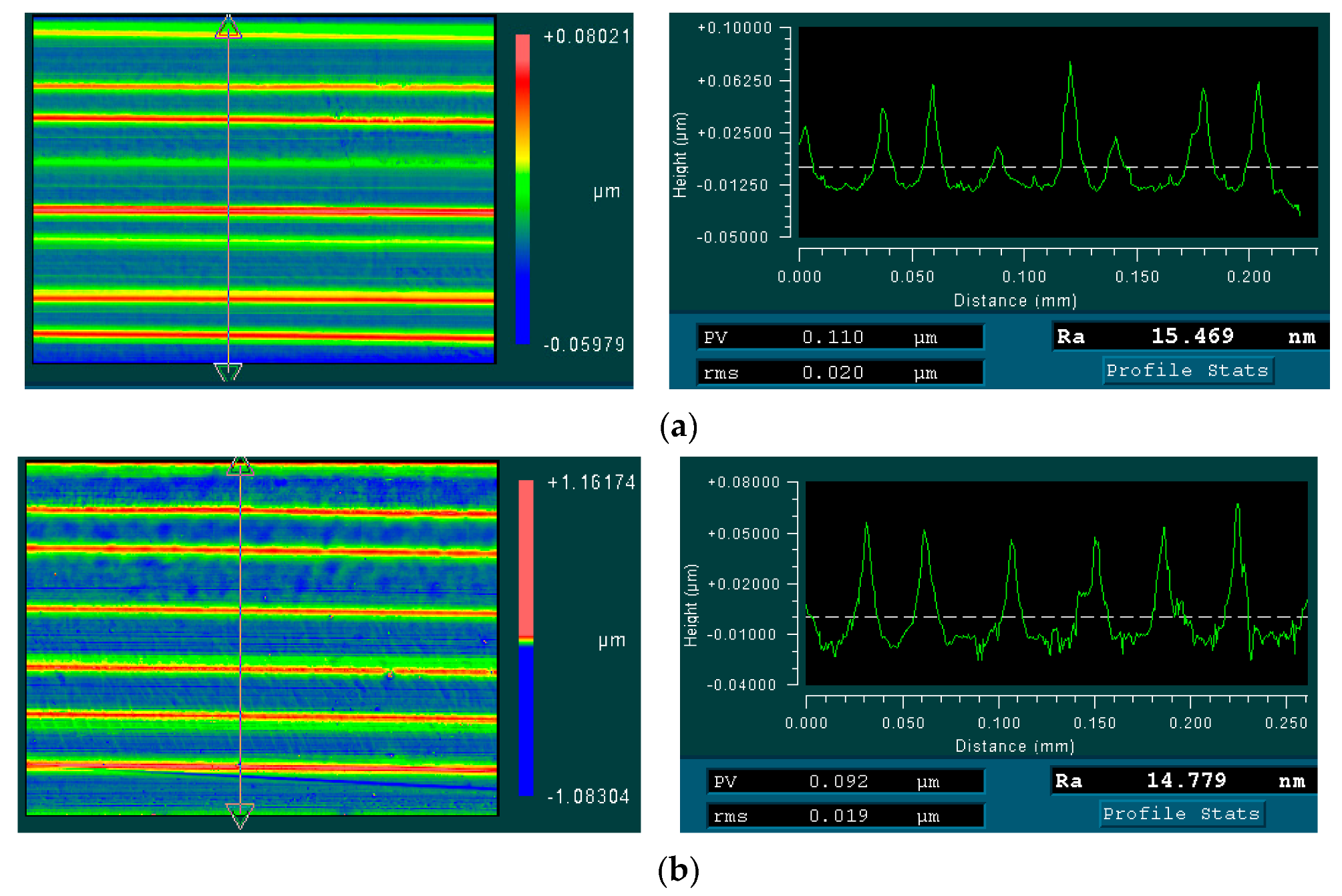
| Parameters | Value |
|---|---|
| Cutting speed v (m/s) | 3.2, 4.8, 6.4, 8.0, 9.6 |
| Depth of cut ap (μm) | 4.0, 6.0, 8.0, 10.0, 12.0 |
| Feed rate fr (μm/r) | 2.4, 4.0, 5.6, 7.2, 8.8 |
Publisher’s Note: MDPI stays neutral with regard to jurisdictional claims in published maps and institutional affiliations. |
© 2022 by the authors. Licensee MDPI, Basel, Switzerland. This article is an open access article distributed under the terms and conditions of the Creative Commons Attribution (CC BY) license (https://creativecommons.org/licenses/by/4.0/).
Share and Cite
Wu, X.; Zhou, Y.; Fang, C.; Zhu, L.; Jiang, F.; Sun, K.; Li, Y.; Lin, Y. Experimental Investigation on the Machinability Improvement in Magnetic-Field-Assisted Turning of Single-Crystal Copper. Micromachines 2022, 13, 2147. https://doi.org/10.3390/mi13122147
Wu X, Zhou Y, Fang C, Zhu L, Jiang F, Sun K, Li Y, Lin Y. Experimental Investigation on the Machinability Improvement in Magnetic-Field-Assisted Turning of Single-Crystal Copper. Micromachines. 2022; 13(12):2147. https://doi.org/10.3390/mi13122147
Chicago/Turabian StyleWu, Xian, Yu Zhou, Congfu Fang, Laifa Zhu, Feng Jiang, Ke Sun, Yuan Li, and Yiyang Lin. 2022. "Experimental Investigation on the Machinability Improvement in Magnetic-Field-Assisted Turning of Single-Crystal Copper" Micromachines 13, no. 12: 2147. https://doi.org/10.3390/mi13122147
APA StyleWu, X., Zhou, Y., Fang, C., Zhu, L., Jiang, F., Sun, K., Li, Y., & Lin, Y. (2022). Experimental Investigation on the Machinability Improvement in Magnetic-Field-Assisted Turning of Single-Crystal Copper. Micromachines, 13(12), 2147. https://doi.org/10.3390/mi13122147







